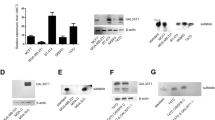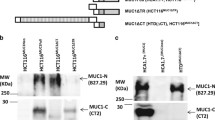Abstract
Overexpression and activation of tyrosine kinase receptors like EGFR and Src regulate the progression and metastasis of Her-2 negative breast cancer. Recently we have reported the role of cell membrane interaction of phospholipid-binding protein annexin A2 (AnxA2) and EGFR in regulating cellular signaling in the activation of angiogenesis, matrix degradation, invasion, and cancer metastasis. Beta-galactoside-specific animal lectin galectin-3 is an apoptosis inhibitor, and cell surface-associated extracellular galectin-3 also has a role in cell migration, cancer progression, and metastasis. Similar expression pattern and membrane co-localization of these two proteins made us to hypothesize in the current study that galectin-3 and AnxA2 interaction is critical for Her-2 negative breast cancer progression. By various experimental analyses, we confirm that glycosylated AnxA2 at the membrane surface interacts with galectin-3. N-linked glycosylation inhibitor tunicamycin treatment convincingly blocked AnxA2 membrane translocation and its association with galectin-3. To analyze whether this interaction has any functional relevance, we tried to dissociate this interaction with purified plant lectin from chickpea (Cicer arietinum agglutinin). This highly specific 30 kDa plant lectin could dissociate AnxA2 from endogenous lectin galectin-3 interaction at the cell surface. This dissociation could down-regulate Bcl-2 family proteins, cell proliferation, and migration simultaneously triggering cell apoptosis. Targeting this interaction of membrane surface glycoprotein and its animal lectin in Her-2 negative breast cancer may be of therapeutic value.






Similar content being viewed by others
Abbreviations
- TNBC:
-
Triple-negative breast cancer
- EGFR:
-
Epidermal growth factor receptor
- Her-2:
-
Epidermal growth factor receptor-2, ERbB-2
- ER:
-
Estrogen receptor
- PR:
-
Progesterone receptor
- STAT:
-
Signal transducer and activator of transcription
- ERK:
-
Extracellular signal-regulated kinases
- RTK:
-
Receptor tyrosine kinase
- GAPDH:
-
Glyceraldehyde-3 phosphate dehydrogenase
- PAGE:
-
Polyacrylamide gel electrophoresis
- IHC:
-
Immunohistochemistry
- FBS:
-
Fetal bovine serum
- MTT:
-
Methyl thiazol tetrazolium
- FITC:
-
Fluorescein isothiocyanate
- tPA:
-
Tissue-type plasminogen activator
- BCA:
-
Bicinchoninic acid
References
Tan AR, Swain SM (2008) Therapeutic strategies for triple-negative breast cancer. Cancer J 14:343–351
Corkery B, Crown J, Clynes M, O’Donovan N (2009) Epidermal growth factor receptor as a potential therapeutic target in triple-negative breast cancer. Ann Oncol 20:862–867
Finn RS (2008) Targeting src in breast cancer. Ann Oncol 19:1379–1386
Dua R, Zhang J, Nhonthachit P, Penue E, Petropoulos C (2010) EGFR over-expression and activation in high HER2, ER negative breast cancer cell line induces trastuzumab resistance. Breast Cancer Res Treat 122:685–697
Zhao WQ, Chen GH, Chen H, Pascale A, Ravindranath L (2003) Secretion of annexin II via activation of insulin receptor and insulin-like growth factor receptor. J Biol Chem 278:4205–4215
Yoo JC, Hayman MJ (2007) Annexin II binds to SHP2 and this interaction is regulated by HSP70 levels. Biochem Biophys Res Commun 356:906–911
Cesarman GM, Guevara CA, Hajjar KA (1994) An endothelial cell receptor for plasminogen/tissue plasminogen activator (t-PA). II. annexin II-mediated enhancement of t-PA-dependent plasminogen activation. J Biol Chem 269:21198–21203
Grewal T, Enrich C (2009) Annexins–modulators of EGF receptor signaling and trafficking. Cell Signal 21:847–858
Dumic J, Dabelic S, Flögel M (2006) Galectin-3: an open-ended story. Biochim Biophys Acta 1760:616–635
Ahmad N, Gabius HJ, Andre S, Kaltner H, Sabesan S, Roy R, Liu B, Macaluso F, Brewer CF (2004) Galectin-3 precipitates as pentamer with synthetic multivalent carbohydrates and forms heterogeneous cross linked complexes. J Biol Chem 279:10841–10847
Partridge EA, Le Roy C, Di Guglielmo GM, Pawling J, Cheung P, Granovsky M, Nabi IR, Wrana JL, Dennis JW (2004) Regulation of cytokine receptors by golgi N-glycan processing and endocytosis. Science 306:120–124
Inohara H, Akahani S, Raz A (1998) Galectin-3 stimulates cell proliferation. Exp Cell Res 245:294–302
O’Driscoll L, Linehan R, Liang YH, Joyce H, Oglesby I, Clynes M (2002) Galectin-3 expression alters adhesion, motility and invasion in a lung cell line (DLKP), in vitro. Anticancer Res 22:3117–3125
Nangia-Makker P, Nakahara S, Hogan V, Raz A (2007) Galectin-3 in apoptosis, a novel therapeutic target. J Bioenerg Biomembr 39:79–84
Castronovo V, Van Den Brule FA, Jackers P, Clausse N, Liu F, Gillet C, Sobel ME (1996) Decreased expression of galectin-3 is associated with progression of human breast cancer. J Pathol 179:43–48
Van Den Brule FA, Buicu C, Berchuck A, Bast C, Deprez M, Liu FT, Cooper DN, Pieters C, Sobel ME, Castronovo V (1996) Expression of the 67-kD laminin receptor, galectin-1, and galectin-3 in advanced human uterine adenocarcinoma. Hum Pathol 27:1185–1191
Lotz MM, Andrews CW Jr, Korzelius CA, Lee EC, Steele GD Jr, Clarke A, Mercurio AM (1993) Decreased expression of Mac-2 (carbohydrate binding protein 35) and loss of its nuclear localization are associated with the neoplastic progression of colon carcinoma. Proc Natl Acad Sci USA 90:3466–3470
Hossaka Thais Ayako, Ribeiro Daniel A, Focchi Gustavo, André Sabine, Fernandes Mariana, Cintra Fernando, Carapeto Lopes, Silva Marcelo Souza, Oshima Celina T F (2014) Expression of Galectins 1, 3 and 9 in normal oral epithelium, oral squamous papilloma, and oral squamous cell carcinoma. Dent Res J 11:508–512
Markowska Anna I, Jefferies Kevin C, Panjwani Noorjahan (2011) Galectin-3 protein modulates cell surface expression and activation of vascular endothelial growth factor receptor 2 in human endothelial cells. J Biol Chem 286:29913–29921
Patchell Benjamin J, Wojcik Kimberly R, Yang Ting-Lin, White Steven R, Dorscheid Delbert R (2007) Glycosylation and annexin II cell surface translocation mediate airway epithelial wound repair. Am J Physiol Lung Cell Mol Physiol 293:L354–L363
Shetty PK, Thamake SI, Biswas S, Johansson SL, Vishwanatha JK (2012) Reciprocal regulation of annexin A2 and EGFR with Her-2 in Her-2 negative and herceptin-resistant breast cancer. PLoS One 7(9):e44299. doi:10.1371/journal.pone.0044299
Das S, Roth CP, Wasson LM, Vishwanatha JK (2007) Signal transducer and activator of transcription-6 (STAT6) is a constitutively expressed survival factor in human prostate cancer. Prostate 67:1550–1564
Qureshi Insaf A, Prasanta Dash P, Srivastava S, Koundal KR (2006) Purification and characterization of an N-acetyl-d-galactosamine-specific lectin from seeds of chic pea (Cicer arietinum L.). Phytochem Anal 17:350–356
Nangia-Makker P, Balan V, Raz A (2008) Regulation of tumor progression by extracellular galectin-3. Cancer Microenviron 1:43–51
Gong HC, Honjo Y, Nangia-Makker P, Hogan V, Mazurak N, Bresalier RS (1999) The NH2 terminus of galectin-3 governs cellular compartmentalization and function in cancer cells. Cancer Res 59:6239–6245
Contessa Joseph N, Bhojani Mahaveer S, Freeze Hudson H, Rehemtulla Alnawaz, Lawrence Theodore S (2008) Inhibition of N-Linked glycosylation disrupts receptor tyrosine kinase signaling in tumor cells. Cancer Res 68(10):3803–3809
de Graauw M, Tijdens I, Smeets MB, Hensbergen PJ, Deelder AM (2008) Anexin A2 phosphorylation mediates cell scattering and branching morphogenesis via cofilin activation. Mol Cell Biol 28(3):1029–1040
Valapala M, Thamake SI, Vishwanatha JK (2011) A competitive hexapeptide inhibitor of annexin A2 prevents hypoxia-induced angiogenic events. J Cell Sci 124:1453–1464
Hayes MJ, Moss SE (2009) Annexin A2 has a dual role as regulator and effector of v-src in cell transformation. J Biol Chem 284:10202–10210
Kassam G, Le BH, Choi KS, Kang HM, Fitzpatrick SL (1998) The p11 subunit of the annexin II tetramer plays a key role in the stimulation of tPA-dependent plasminogen activation. Biochemistry 37:16958–16966
Sharma M, Ownbey RT, Sharma MC (2010) Breast cancer cell surface annexin II induces cell migration and neoangiogenesis via tPA dependent plasmin generation. Exp Mol Pathol 88:278–286
Ling Q, Jacovina AT, Deora A, Febbraio M, Simantov R (2004) Annexin II regulates fibrin homeostasis and neoangiogenesis in vivo. J Clin Invest 113:38–48
Zhang S, Huang WC, Li P, Guo H, Poh SB (2011) Combating trastuzumab resistance by targeting SRC, a common node downstream of multiple resistance pathways. Nat Med 17:461–469
Jorissen RN, Walker F, Pouliot N, Garrett TP, Ward CW (2003) Epidermal growth factor receptor: mechanisms of activation and signaling. Exp Cell Res 284:31–53
Hajjar KA, Krishnan S (1999) Annexin II: a mediator of the plasmin/plasminogen activator system. Trends Cardiovasc Med 9:128–138
Kirsch T, Harrison G, Golub EE, Nah HD (2000) The roles of annexins and types II and X collagen in matrix vesicle-mediated mineralization of growth plate cartilage. J Biol Chem 275:35577–35583
Morel E, Gruenberg J (2009) Annexin A2 binding to endosomes and functions in endosomal transport are regulated by tyrosine 23 phosphorylation. J Biol Chem 284:1604–1611
Dricu A, Carlberg M, Wang M, Larsson O (1997) Inhibition of N-linked glycosylation using tunicamycin causes cell death in malignant cells: role of down-regulation of the insulin-like growth factor 1 receptor in induction of apoptosis. Cancer Res 57:543–548
Fernandes H, Cohen S, Bishayee S (2001) Glycosylation induced conformational modification positively regulates receptor-receptor association: a study with an aberrant epidermal growth factor receptor (EGFRvIII/DEGFR) expressed in cancer cells. J Biol Chem 276:5375–5383
Guo HB, Randolph M, Pierce M (2007) Inhibition of a specific N-glycosylation activity results in attenuation of breast carcinoma cell invasiveness-related phenotypes: inhibition of epidermal growth factor-induced dephosphorylation of focal adhesion kinase. J Biol Chem 282:22150–22162
Wang X, Gu J, Ihara H, Miyoshi E, Honke K, Taniguchi N (2006) Core fucosylation regulates epidermal growth factor receptor-mediated intracellular signaling. J Biol Chem 281:2572–2577
Acknowledgments
Authors like to acknowledge Mr. Harikrishna Ellanki for technical help.
Author information
Authors and Affiliations
Corresponding author
Ethics declarations
Conflicts of interests
The authors have declared that no competing interests exist.
Funding
This work was supported by Indian Council of Medical Research (ICMR) Ad hoc grant, IRIS No. 09390 to Dr. Praveenkumar Shetty, partly by SDM Institutional grant and seed funding from Karnataka Cancer Therapy and Research Institute, Hubli. The funders had no role in study design, data collection, and analysis, decision to publish or preparation of the manuscript.
Rights and permissions
About this article
Cite this article
Shetty, P., Bargale, A., Patil, B.R. et al. Cell surface interaction of annexin A2 and galectin-3 modulates epidermal growth factor receptor signaling in Her-2 negative breast cancer cells. Mol Cell Biochem 411, 221–233 (2016). https://doi.org/10.1007/s11010-015-2584-y
Received:
Accepted:
Published:
Issue Date:
DOI: https://doi.org/10.1007/s11010-015-2584-y




